David Jonkin or Jenkin (died 1641) was a Scottish merchant and shipowner. He imported sugar, French wine, Swedish timber, linen from Haarlem, and lint from Poland.

David Jonkin or Jenkin (died 1641) was a Scottish merchant and shipowner. He imported sugar, French wine, Swedish timber, linen from Haarlem, and lint from Poland.

An early notice of David Jonkin's merchant activity appears in a manuscript record of Edinburgh's Baillie court. It was found in April 1616 that Elizabeth Nicholson owed Jonkin £47 for goods. She had bought the items from Jonkin when her husband John Aslowane was still alive, and it was a principle of Scottish law that a husband was responsible for the payments of debts contracted by his wife. [1]
Jonkin was able to extend credit, and in August 1623 lent 500 guilders to Alexander Erskine at The Hague. Erskine, a son of John Erskine, Earl of Mar (1558–1634), was at the court of Elizabeth Stuart, Queen of Bohemia and was equipping himself to fight in her cause. [2]
Jonkin sold food, wine, coal, and other goods, and owned and held part shares in a number of ships. In 1625 he was part owner of the St John of Leith, built in Rotterdam in 1624, [3] with George Gourlay as master, and had shares in the Alexander and Love of Leith, and the Bruce. [4]
David Jonkin was fined for breaking Edinburgh's market regulations in 1624 when it was discovered he was buying imported food in Burntisland to profiteer during a famine. [5] He sold claret and white wine to the Earl of Winton in 1628. [6]
Jonkin and a business partner David Cruikshanks shipped cloth to Spain in the Blessing of Leith in October 1633. The textiles, re-exported rather than manufactured in Scotland, included coloured buckram, say, and "ambobrudge buckasie", a Hamburg cloth. [7] Jonkin was Cruikshank's landlord for a property on the Royal Mile. [8]
In 1634 Jonkin and Patrick Wood had a patent to start manufacturing cables and rope for ships and recruit foreign craftsmen for their works in Edinburgh or Leith. [9]
Jonkin had a booth or shop situated under the Tolbooth in Edinburgh, rented from the burgh council. [10]
By 1636 David Jonkin acquired joint ownership with Thomas Gledstanes of a house on Edinburgh's Lawnmarket on the High Street now called Gladstone's Land. [11] They had flats in the building, and their tenants included two lawyers, Andrew Hay and John Adamson. [12]
Jonkin supported the Scottish Covenant in 1639 by selling firearms to the Earl of Argyll and buying a warship in Holland. [13]
He married twice. His first wife, Margaret Lauder or Baxter died in November 1625, her children were Hercules, John, and Margaret Jonkin.
Jonkin died on 28 February 1641. [14]
His will lists his stock, including armour, and the value of his five ships, [15] and sums of money owing to him, and debts for making gunpowder. The Earl of Moray had bought wainscot timber from Jonkin.

Mary of Guise, also called Mary of Lorraine, was Queen of Scotland from 1538 until 1542, as the second wife of King James V. She was a French noblewoman of the House of Guise, a cadet branch of the House of Lorraine and one of the most powerful families in France. As the mother of Mary, Queen of Scots, she was a key figure in the political and religious upheaval that marked mid-16th-century Scotland, ruling the kingdom as queen regent on behalf of her daughter from 1554 until her death in 1560.

Leith is a port area in the north of Edinburgh, Scotland, founded at the mouth of the Water of Leith.

John Erskine, 1st Earl of Mar was a Scottish aristocrat and politician. He was the custodian of the infant James VI of Scotland and Regent of Scotland.

George Keith, 5th Earl Marischal (c. 1553–1623) was a Scottish nobleman and Earl Marischal. He succeeded as earl on 7 October 1581, upon the death of his grandfather, William Keith, 4th Earl Marischal.
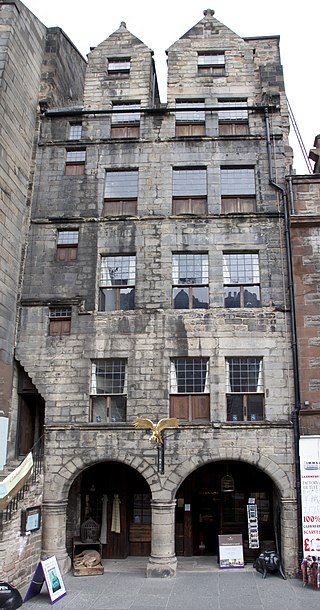
Gladstone's Land is a surviving 17th-century high-tenement house situated in the Old Town of the city of Edinburgh, Scotland. It has been restored and furnished by the National Trust for Scotland, and is operated as a popular tourist attraction.

Sir Robert Baird (1630–1697) was a Scottish merchant, landowner, and investor in colonial enterprise in the Province of Carolina.
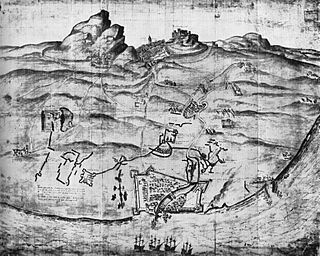
The siege of Leith ended a twelve-year encampment of French troops at Leith, the port near Edinburgh, Scotland. French troops arrived in Scotland by invitation in 1548. In 1560 the French soldiers opposed Scottish supporters of religious reformation, and an English army arrived to besiege the French garrison at Leith. The town was not taken by force and the French troops finally left peacefully under the terms of a treaty signed by Scotland, England and France.
Lion was the name of five warships of the Royal Scottish Navy during the 16th century, some of which were prizes captured by, and from the English. The names of these ships reflect the Royal Arms of Scotland and its central motif of the Lion Rampant.
The Burning of Edinburgh in 1544 by an English army was the first major action of the war of the Rough Wooing. The Provost of Edinburgh was compelled to allow the English to sack Leith and Edinburgh, and the city was burnt on 7 May. However, the Scottish artillery within Edinburgh Castle harassed the English forces, who had neither the time nor the resources to besiege the Castle. The English fleet sailed away loaded with captured goods, and with two ships that had belonged to James V of Scotland.

The King's Wark in Leith was a building on the Shore of Leith, at the mouth of the Water of Leith into the Firth of Forth. The King's Wark was the Scottish royal arsenal where cannon used on royal ships were kept and maintained, and where supplies shipped to Leith for the royal household were stored. To the north east of the King's Wark the Shore was extended into the sea by a pier known as the "Bulwark". To the west was the Broad Wynd, and on the south, there was a walled yard. An inn on the site was documented in 1623. The site on the Shore includes a public house and restaurant called "The King's Wark" on the corner of the Shore and Bernard Street.
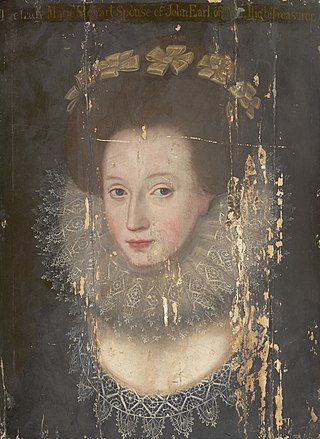
Marie Stewart, Countess of Mar (1576-1644) was a Scottish courtier. She was the daughter of Esmé Stewart, 1st Duke of Lennox and Catherine de Balsac d’Entragues (d. c.1631) and a favourite of James VI of Scotland. After her marriage, as was customary in Scotland, she did not change her name, and signed her letters as "Marie Stewart".

Claude de l'Isle de Marivaux was a French diplomat working for Henry of Navarre.
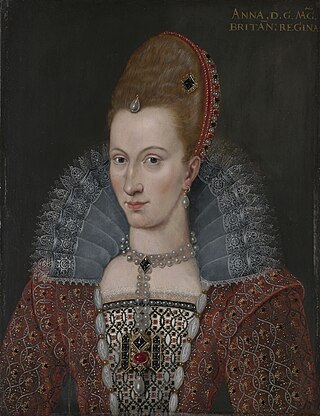
On 17 May 1590, Anne of Denmark was crowned Queen of Scotland. There was also a ceremony of joyous entry into Edinburgh on 19 May, an opportunity for spectacle and theatre and allegorical tableaux promoting civic and national identities, similar in many respects to those performed in many other European towns. Celebrations for the arrival of Anne of Denmark in Scotland had been planned and prepared for September 1589, when it was expected she would sail from Denmark with the admirals Peder Munk and Henrik Gyldenstierne. She was delayed by accidents and poor weather and James VI of Scotland joined her in Norway in November. They returned to Scotland in May 1590.

Jacques de Bousie was a Flemish confectioner known as a "sugarman" working in Edinburgh, Scotland, employed by James VI and Anne of Denmark.
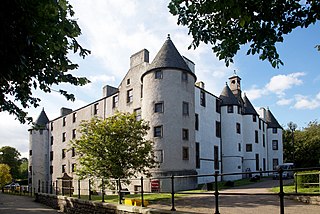
James Scrimgeour Scottish landowner and Constable of Dundee.
Robert Jameson was a Scottish shipowner from Ayr.
Jerome Bowie was a servant of James VI of Scotland as a sommelier and Master of the Wine Cellar, in charge of the purchase and serving of wine.
William Murray of Tullibardine (1510–1562) was a Scottish landowner.

Alexander Oustean or Oustian or Austin was a Scottish tailor and member of Edinburgh burgh council.

The first Leith Sugar House was established in 1677 by Robert Douglas and partners. Between 1667 and 1701 four sugar boiling and rum-distilling enterprises were established in Scotland, three in Glasgow and one in Leith. The financial success of the Leith Sugar house in the seventeenth and eighteenth century demonstrates Edinburgh's economic connection to the Atlantic economy and enslaved labour.